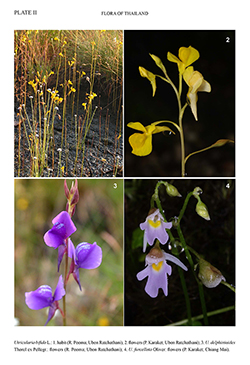e-Flora of Thailand
Volume 11 > Part 1 > Year 2011 > Page 21 > Lentibulariaceae > Utricularia
3. Utricularia bifida L.
Sp. Pl. ed. 1. 1: 18. 1753; A.DC. in DC., Prodr. 8: 21. 1844; C.B.Clarke in Hook.f., Fl. Brit. India 4: 332. 1885; Trimen, Handb. Fl. Ceylon 3: 270. 1895; Craib, Bull. Misc. Inform. Kew 1911: 429. 1911; Craib, ibid. 1912: 147. 1912; Ridl., Fl. Malay Penin. 2: 492. 1923; Pellegr. in Lecomte, Fl. Indo-Chine 4: 482. 1930; Back. & Bakh.f., Fl. Java 2: 518. 1965; P.Taylor, Dansk Bot. Ark. 23: 529. 1968; in Fl. Males., Ser. I, Spermat. 8: 281. 1977; Rani & Matthew in Matthew, Fl. Tamilnadu Carnatic 2: 1112. 1983; Maxwell, Songklanakarin J. Sci. Technol. 7: 413. 1985 (excl. var. bosminifera); P.Taylor, Kew Bull. Addit. Ser. 14: 307. 1989; in Dassanayake & Clayton, Rev. Handb. Fl. Ceylon 9: 182. 1995; Hô, Câyco Viêtnam 3: 113. 1993; Noltie in Grierson & Long, Fl. Bhutan 2: 1340. 2001; Maxwell & Elliot, Veg. & Vasc. Fl. Doi Suthep - Doi Pui Nat. Park, Northern Thailand: 106. 2001. Plate II: 1–2.
Accepted Name : This is currently accepted.
Synonyms & Citations :
Description : Usually terrestrial. Stolons infrequent, filiform. Rhizoides filiform, branched. Floats absent. Leaves linear, usually absent at flowering, 1–2 cm long, 1-nerved. Auricles absent. Traps usually numerous, reniform, 0.5–1 mm long; mouth basal, with 2 very fragile appendages (often absent due to damage in dried specimens), often blackish. Internal hairs 1-armed or 2-armed. Inflorescence erect, solitary, (3–)14(–20) cm long; peduncle hairless; usually 3–7(–15)-flowered; flowers widely spaced, and, when young, often held such that mouth of the flower is upright, the upper lip of the corolla and spur are arranged parallel to the peduncle and that part of the lower lip below the palate is held horizontally. Scales infrequent, similar to bracts. Bracts ovate, attached at the base, 1–1.5 mm long, blunt at tip, occasionally pinkish tinged. Bracteoles subulate, ca 0.5 mm long. Pedicels ca (1–)3–4 mm in flower, and erect; strongly deflexed and enlarged in fruit. Calyx lobes subequal, 2–3 mm long on flowering, the lower sometimes with a shortly bifid/emarginate apex; sometimes reddish tinged, markedly expanded in fruit with the margins forming a conspicuous, flattened rim around the fruit. Corolla usually yellow; 6–10(–12) mm long; very rarely whitish-yellow, upper lip erect, much smaller than lower lip, lower lip spreading horizontally to erect, both occasionally with red markings, palate prominent, often deeper yellow; spur 3–4(–7) mm long, downward facing, straight to slightly curved, long pointed. Seeds ovoid, often with one end clearly truncated, ca 0.5 mm long.
Thailand : NORTHERN: Mae Hong Son, Chiang Mai, Uttaradit, Phitsanulok; NORTH EASTERN: Loei, Sakhon Nakhon, Mukdahan, Khon Kaen; EASTERN: Chaiyaphum, Nakhon Ratchasima, Buri Ram, Ubon Ratchathani; CENTRAL: Nakhon Nayok; SOUTH-EASTERN: Sa Kaeo, Chon Buri, Chanthaburi; Trat; PENINSULAR: Surat Thani, Phangnga, Trang, Satun, Songkhla, Narathiwat.
Distribution : India to Japan and Australia.
Ecology : Wet, marshy often sandy and often acidic ground, occasionally on wet rocks, rarely in shallow water; most frequently recorded from 300–600 m alt., but ranging from (0–)200–1,300 m. Flowering and fruiting: mainly August–January.
Vernacular : Soi suwanna (สร้อยสุวรรณา); sarai dok lueang (สาหร่ายดอก เหลือง), lueang pit samon (เหลืองพิศมร)(Central); ya si thong (หญ้าสีทอง)(Loei).
Notes: Possibly the second commonest, certainly the commonest yellow-flowered terrestrial Utricularia species in Thailand.

